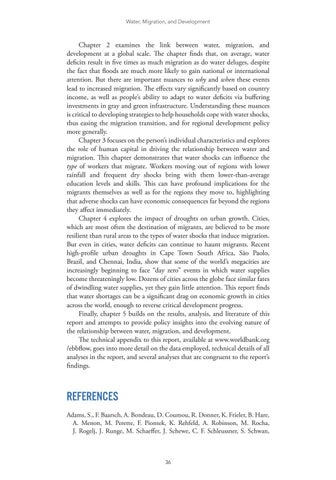Water, Migration, and Development
Chapter 2 examines the link between water, migration, and development at a global scale. The chapter finds that, on average, water deficits result in five times as much migration as do water deluges, despite the fact that floods are much more likely to gain national or international attention. But there are important nuances to why and when these events lead to increased migration. The effects vary significantly based on country income, as well as people’s ability to adapt to water deficits via buffering investments in gray and green infrastructure. Understanding these nuances is critical to developing strategies to help households cope with water shocks, thus easing the migration transition, and for regional development policy more generally. Chapter 3 focuses on the person’s individual characteristics and explores the role of human capital in driving the relationship between water and migration. This chapter demonstrates that water shocks can influence the type of workers that migrate. Workers moving out of regions with lower rainfall and frequent dry shocks bring with them lower-than-average education levels and skills. This can have profound implications for the migrants themselves as well as for the regions they move to, highlighting that adverse shocks can have economic consequences far beyond the regions they affect immediately. Chapter 4 explores the impact of droughts on urban growth. Cities, which are most often the destination of migrants, are believed to be more resilient than rural areas to the types of water shocks that induce migration. But even in cities, water deficits can continue to haunt migrants. Recent high-profile urban droughts in Cape Town South Africa, São Paolo, Brazil, and Chennai, India, show that some of the world’s megacities are increasingly beginning to face “day zero” events in which water supplies become threateningly low. Dozens of cities across the globe face similar fates of dwindling water supplies, yet they gain little attention. This report finds that water shortages can be a significant drag on economic growth in cities across the world, enough to reverse critical development progress. Finally, chapter 5 builds on the results, analysis, and literature of this report and attempts to provide policy insights into the evolving nature of the relationship between water, migration, and development. The technical appendix to this report, available at www.worldbank.org /ebbflow, goes into more detail on the data employed, technical details of all analyses in the report, and several analyses that are congruent to the report’s findings.
REFERENCES Adams, S., F. Baarsch, A. Bondeau, D. Coumou, R. Donner, K. Frieler, B. Hare, A. Menon, M. Perette, F. Piontek, K. Rehfeld, A. Robinson, M. Rocha, J. Rogelj, J. Runge, M. Schaeffer, J. Schewe, C. F. Schleussner, S. Schwan,
36



